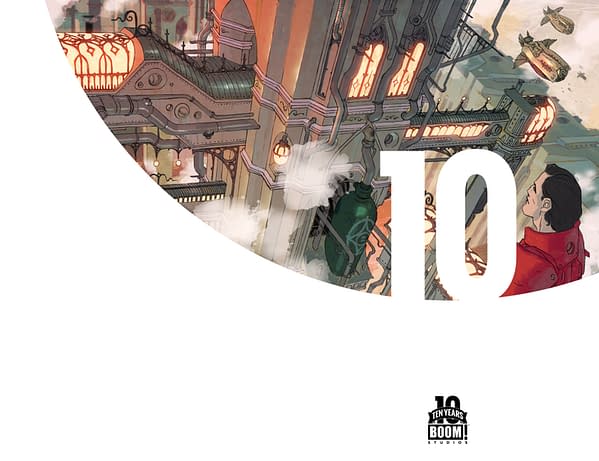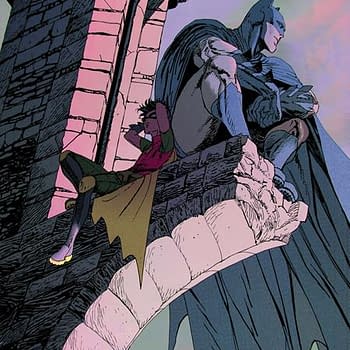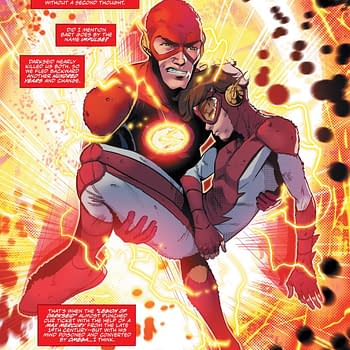Posted in: Comics | Tagged: archaia, boom, Comics, entertainment, lantern city, Matt Daley, rise, steampunk, Trevor Crafts, tv
Inside The Steampunk Social Struggles Of Lantern City With Trevor Crafts And Matthew Daley
As Bleeding Cool reported a few days ago, Lantern City will be Archaia's largest launch ever, at 10,000 copies with social media presence very high, and promo packages getting retailers involved in the excitement over the new monthly Steampunk series already scheduled to last at least 12 issues. Two weeks ago WonderCon was part of the Lantern City spotlight as two of the writers on the book, Trevor Crafts and Matthew Daley, appeared on the Archaia/Boom panel to promote the series, did signings, and had a fully armored Grey Empire "Guard" parading at the booth rather menacingly. He did give out Lantern City pins, however, so wasn't entirely malevolent.



Hannah Means-Shannon: The world of Lantern City looks vast and sweeping. I've heard it described as Steampunk, but I see science fiction elements as well in terms of setting and possible technology.
Trevor Crafts: Yes. It's essentially "our" Steampunk. It's Lantern City's Steampunk. We have worked with a lot of the great Steampunk artisans who are on the scene right now, like Tom Banwell who designed the Lantern City Guard mask for us. It's such a maker community, that we really wanted that involvement from fans. But we certainly wanted our own twist on our own look for Steampunk. We've been building our own universe for a few years now. It doesn't necessarily take place in Victorian England. This is an alternate world. There will be some science fiction elements as well. But we have planted the flag in terms of Steampunk. So much of Steampunk has political intrigue and revolutionary aspects to it as well, including class warfare. That's very deeply entrenched in our world and our universe.
HMS: And this is a very big universe from what I can see. It's an epic universe, really.
TC: It's pretty big. We've built the story of Lantern City around the city itself, which is sprawling and multi-layered.
Matt Daley: The one thing we really wanted to accomplish early on was to have a self-contained world, even though it's not all it exists, for the people who live there it seems to be. A couple city blocks just wouldn't have been enough. So we have created the history of why it is so massive, and why everyone is shut out from the outside world.
TC: Prior to the comic book, we created an illustrated novel called Rise, which is on amazon and with booksellers still. That takes place 200 years before the comic series starts. It's all about Isaac Foster Grey who is the ruler and creator of Lantern City. It chronicles his story to set up the beginning of the story. So in terms of it being a big world, we begin 200 years beforehand and the history continues all the way through, so it is a massive place with lots of history.
MD: There's a lot that happens even before that point, but for our world building purposes, it exists within the 200 year span. There's also a world outside of Lantern City that we've created, but for the people who live inside, there have been generations who have only lived within this city.
TC: All the media is controlled by the Grey Empire, too, so they are the writers of history, or the revisionists of history.
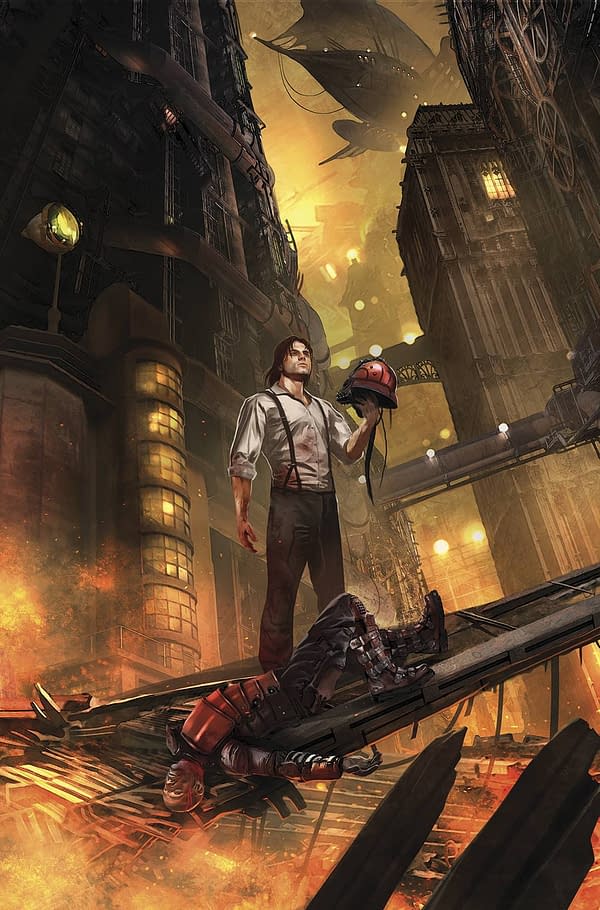
MD: It depends on the strata you belong to. If you are a member of the ruling class, you have a very luxurious life, although it's got its downsides as well in terms of vying for power.
TC: But at that level, it's all opulence too. And excess. It's far removed from the world below. The street-level people are the farmers and the factory workers who make the world run. That's a step up from slavery, really.
MD: It's slave labor, essentially.
TC: Then you have an entire Underground culture, too, because when the city was founded by Isaac Foster Grey, who was kind of a military genius, he determined that the city needed a place where everyone could flee to. He built a massive bunker that spans city. But that was then co-opted by a more criminal culture. Not only criminal culture, though, because if you decide you don't want to be a cog in this wheel, you might end up there. But it's a no holds barred kind of criminal world.
MD: There's no sun there, either. You're living literally underground.
TC: From a comic aspect, this is a great range of classes and settings because we can use all the different styles of Steampunk. We have the gorgeous finery and Downton Abbey-esque costuming and things I like to call "Fifth Element style" costuming because you get these fabulous Jean Paul Gautier style pieces. They are all still Steampunk style. Then there's the working class, which is the hardcore Steampunk group, and the Underground, where anything goes.
MD: Where everything goes crazy. Machinery and pistons, and all the gears.
HMS: So, they are down in the guts of the city? The operational elements of the city are there too?
MD: Oh, yes. So, think of going down into the underground of New York or London, and then being cut off down there.
HMS: Like being in steerage in a boat?
TC: Yes, pretty much! The workers themselves are in tight apartments and tenement houses, and they have jobs they go to every day. They have very little education. But the Underground is where we can go crazy.
And our artist, Carlos Magno, is doing an amazing job. When I first met with Boom about the series, Ross Richie and Stephen Christy, they said that Carlos was coming right off Robo Cop and might be good to do the series. And we said yes to that!

HMS: Presumably, a kind of evolutionary competition is going on in the Underground without any structure.
TC: Oh, yes. And that's where the gangs and the criminal elements thrive. You can almost look at it as violence as a theme in the city. Because the Grey Empire deals in political violence, always vying for power…
MD: …including an almost psychological violence in their role…
TC: Yes. And the workers experience violence in the form of the Lantern City Guard, the oppressive police force of the Grey Empire. They have to constantly accept that. But then when you get into the Underground, it's violence all the time in a lawless land.
HMS: So, are there any different cultural elements in Lantern City or is class the major form of division among the people?
MD: Class is the major dividing factor. It was at one point a culturally diverse city, because when Lantern City was formed, it combined 5 distinct cities. It would be like taking Boston, New York, Philadelphia, Atlanta, and New Orleans together and putting them into one massive city. The diversity is not a source of conflict the way class would be, though. There's a sense of being "all in this together".
TC: The place where you would see some cultural divisions would be in the Underground. There it's a mash-up of every place on Earth thrown together, conceptually. There is a lot of Asian influence, for instance, and all parts of the globe.
HMS: So, in creating your Steampunk world you've drawn on multiple real-world cultural influences?
TC: 100%, yes. I think that the Grey Empire is more of a traditional European style empire. But really where we get into the cross-cultural elements is in the Underground.
MD: Well, one thing that happens in every city is that each has their leaders, and they bring their power and cultural concerns with them.
HMS: Are we going to see characters from all of these different classes and strata in the comics?
TC: Absolutely.
MD: That was the most important thing we had to figure out for the comic book was how to have a character who could navigate all three classes. That's not a natural thing to do in Lantern City. That was a challenge to figure out.
TC: Another thing that was important to figure out was the core question that Lantern City asks, whether as a TV show, an illustrated novel, or a comic book. It all boils down to: "How far would you be willing to go to be with the people you love the most?" So our hero, Sander Jorve, who is our main character, is a working class guy, with a wife and a kid. Essentially, he is thrust into this campaign to infiltrate the Lantern City Guard. He has to navigate and become the thing he hates the most to make sure he creates a better life for his wife, his son, and everybody.
HMS: He wants to, or has to become a Guard member?
TC: He is given the opportunity to become a Guard.
MD: And he's certainly reluctant to do that.
TC: Essentially, it becomes a deep cover operation.
MD: He's pretending to be someone he's not.
TC: His wife's brother, a character called Kendall, who is played in the show and also in the comic book by Raphael Sbarge, from Once Upon a Time, is a very educated worker. He's leading a peaceful workers' revolt agains the Grey Empire. At the beginning of the comic, the Guard invade a rally and essentially disrupt it. Well, it's an all-out raid.
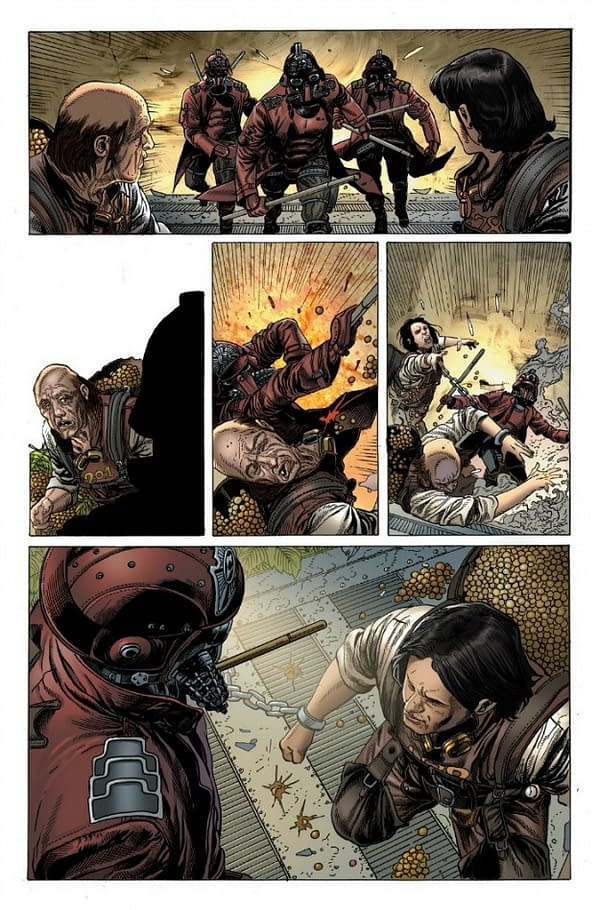
TC: Yes. All that happens in the first issue. He's given this opportunity to protect his family and he has to do this to make a better world for them.
That's the way that Sander can move through these social strata, from worker class member, to Lantern City Guard, to infiltrating all the way up into the Grey Empire itself.
MD: As well as below, into the Underground.
TC: It gives him access to pretty much everything to have this role.
MD: It was easier for the show to figure out how to move between the classes, but for the comic, we needed one character who could do that. We didn't want to splinter off into too many main characters to follow. We wanted to introduce one character to show the world of Lantern City.
HMS: It's all the rage right now to have a massive cast of characters, which can be very exciting, as in Game of Thrones, but unless it's done well, that does tread a fine line on losing the viewer's full understanding. They might get slices of life but they don't develop a deep connection to a particular character. In the most extreme cases, if there are many characters, you suppose that many of them are going to die, so you don't necessarily get as attached to them, on purpose.
MD: It's interesting because the appeal of having a lot of characters helps the reader explore the world and you can show many interesting things through that, but there's a downside.
TC: Matt and I have created, I think in all, about 70 characters.
MD: And we need them.
TC: We don't focus on all of them, but as we said, it's a big, big world. We can have lots of different areas for lots of different stories.
HMS: How does the story of the show follow or relate to the story of the comic?
TC: The story of the show is actually totally different.
MD: It would have been tough to do the show as a comic.
TC: Essentially, one of the elements of Lantern City which gives it its namesake, is a magic lantern. It's not actually magic, but that was the term in the 18th century for a slide projector. And here it actually allows for transport from our world to Lantern City. That's what the show focuses on. Three people from our world get transported to Lantern City. And it's not like a Star Gate, where people go to the other side, and dial in a destination. It's a singular kind of path. We explore that in Rise. There's a person from our world who ends up in Lantern City.
MD: Presumably the first person to do so…
TC: In terms of the show, we realize that comic readers are quite different than TV viewers. Comic readers are actually much more comfortable jumping into the world of the story, and getting into all the minutiae and nitty gritty. A lot of the characters we see in the show also appear in the comic, but one of the great things about the comic is that we didn't have to present the world of the comic through the eyes of someone who had just arrived and was seeing all kinds of amazing things in Lantern City. Essentially this story happens right before the TV show.
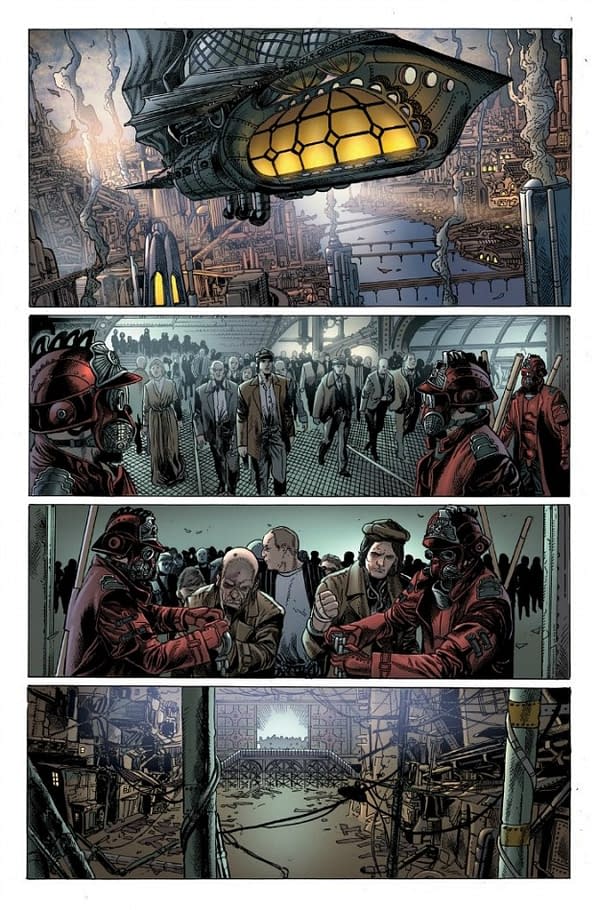
TC: Correct.
MD: We don't have to have an outsider coming in to be the guide for the reader, but usually if someone is from this world, their lives are very segmented. You go to work, you stay in your neighborhood. Transportation is minimal. You don't travel the city much. So, even though Sander knows of other parts of the city, and has heard of them, he might never have expected to be there.
TC: It's almost like someone who lives in New York never having seen the Freedom Tower. It happens. I used to live in New York, and I've never been to the Statue of Liberty.
HMS: It happens.
TC: Through Sander, we're experiencing the amazing, huge nature of the Grey Empire and the sordid, street level Underground. Because it's all new to him, it keeps things fresh. We all sort of feel like we want something bigger and more, but don't know how to get it. And we all make sacrifices about our jobs, how much money we want to make, how happy we are, how happy we want to be. We ask ourselves if we should stick where we are and not make waves because it's safe, even though there's all this greatness we want to attain. I think that's really where Sander has some of his core struggles.
MD: Another benefit is, for him, he doesn't even know if he wants anything else, because he's never seen anything else.
HMS: It sounds like he's going to be introduced to a whole new series of possible temptations.
TC: Yes. And that's part of the question for him. Does he really want to go back? If all of the sudden, you were flying around Dubai in a jet with unlimited funds, you might think, "What's this mission I had in mind? Maybe I don't need to go back". But that's where his struggles lie.
MD: The benefit of having a native of the city there as a central character is that he knows how to behave in some areas of life in the city, and theoretically how to behave in other areas. He's heard enough about the Underground that he knows in part how to act and how not to act. He could be wrong, but at least he's not so naive and drop-jawed as he might be otherwise.
TC: He's a tough, resourceful character.
HMS: And he has a chance at this, at least a chance of survival in this situation.
MD: Exactly. And where he grew up makes him even tougher and more resourceful in terms of survival.
HMS: As modern people, and members of a democracy, we can critique the social classes at work in Lantern City, but this story is obviously going to display that people are equal and have equal potential regardless of class, I'm assuming. Sander is upwardly mobile.
TC: Well, it wouldn't be allowed for someone to be mobile in Lantern City. The only way to do it is through the Guard. If you are a Guard, you were working class originally, and then you get placed into a totally separate class, really its own class.
HMS: Oh, it's like the Roman Empire. You can move upward through military standing?
MD: Exactly. You can move up into the ruling class an be an employee in that world. There are working class people who serve them, and they are separated as well. They live in improved and nice neighborhoods.
TC: It's kind of like Elizabethan England.
HMS: Yes, I was going to say, it sounds like you serve at court, and you could do very well that way. You become like the people you serve.
TC: Kendall is a character who is self-educated by contrast, and is as aristocratic as you can be in the worker class. And also since there's 200 years of history to work with, Killian Grey, is the new, young ruler of Lantern City and he is the fourth ruler. His grandfather was Isaac Foster Grey. It's a male bloodline.
HMS: So, what's the deal with these guys?! Do they have ideals and think they are doing well for the people of Lantern City, or are they just despots?
TC: We actually haven't explored that storyline fully yet, but that's something that happens in the transition between the first ruler, Isaac Foster Grey, and his son, Alan Hibbert Grey, where there's an ideal shift. Isaac really tried to make this shining city, this perfect example, for everyone, and his son twisted it.
MD: He also learns, because he rules the city for a long time, that everyone has different methods for getting what they want, and he has to change. He may have had all these great ideals, but he realizes everyone is vying for the same thing in different ways.
TC: To go back to Game of Thrones, it's like the Daenerys Targaryen conversation last season. Being a queen and ruing all these people kind of sucks. And then your dragon goes and harms people and makes life really difficult for everybody.
HMS: Yes. So, is there sympathy? Do you guys feel sympathy for this ruling family, or are they just bastards?
TC: The interesting thing about all of the characters within Lantern City is that everyone is very multi-layered. So, Killian himself is a tyrant, and a maniacal leader, but at the same time, he is incredibly charismatic, ridiculously smart, and at the same time he's a great strategist.
HMS: We'll still be interested by him.
TC: Yes, we're not going with the standard tropes of a bad guy.
HMS: Which is a danger in comics when you're trying to tell an epic story, using shorthand to define characters.
TC: Well, the nice thing is that we don't have to worry about speed, because we are a monthly comic, with a lot of room to explore. And that's the nice thing about working with Archaia and Boom, and working with Carlos, is that Carlos is incredibly fast, and cranks the pages out, and Matt is by far the fastest writer I've ever worked with too.
MD: To go back to the topic of characters for a second, I think the important thing is that whether you like them or not, you understand why they do what they do.
HMS: It keeps you from making snap judgments as a reader and it keeps you paying attention to the details, too.
TC: We are exceedingly excited to bring this to the world.
HMS: When is Lantern City arriving?
TC: It's arriving May 13th. It will essentially be the second Wednesday of every month after that. I think that's something for the core Steampunk fans. There has not been a monthly Steampunk comic that they could count on. This is something to count on, and they'll be able to swim in all these new characters and in this new world.
Lantern City #1 arrives on May 13th, the first issue of a 12-part series, is currently listed in Previews World with item code: MAR151070 and reaches FOC today, April 20th.
Fans can find out more about the series at http://www.lanterncitytv.com, www.facebook.com/lanterncitytv, and on http://twitter.com/LanternCityTV If you want to meet up with the team live in the next few months, you can find them at C2E2 in Chicago, and Atlantic City Boardwalk Con in NJ. They will also be attending San Diego Comic Con in July.


